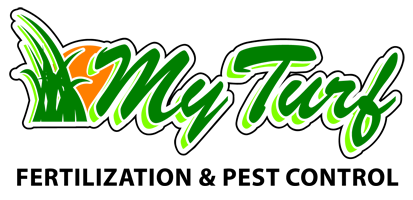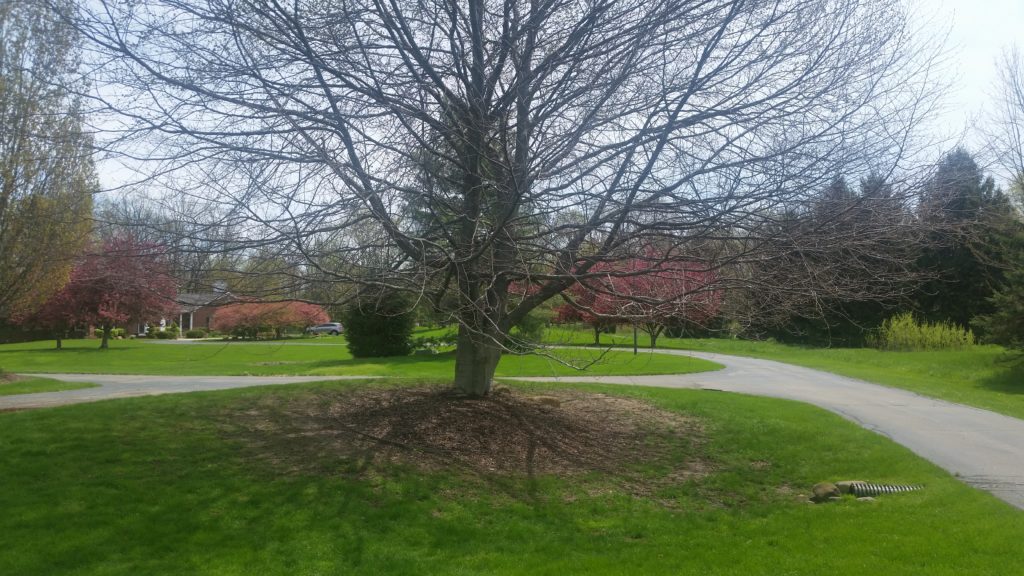Are you struggling to grow grass in the shade? A common problem we see in the spring wake up period is poor turf density within the drip line of a tree. Depending on the situation, a thick turf in these areas may or may not be possible. There are several factors at play here, which will need to be addressed to encourage new grass in these weak shade areas. Keep in mind that shade areas will be the slowest to wake up in the springtime and can take up to a month longer than sunny areas to grow up to full mowing height.
Soil- What is below the tree? If you have a towering maple tree with a 30′ wide drip line, just imagine the root system below your feet that is necessary to keep that tree alive. Evergreen trees have a very shallow fibrous root system that is very close to the surface as well. As these roots grow they take up more and more space and compact the soil more and more, leaving very little growing media for the tender grass to take root in. In addition to that, as air temperatures rise these tree roots remove much of the moisture out of the soil and will dry out the grass under the tree quite quickly. What’s the solution? Four things need to be done: 1. Core aerate around the tree to loosen the soil as much as possible and add a thin layer (.5-1″ thick) of new soil to the area when seeding. The new seed will root into the loose soil and be uninterrupted by the tree roots. Unfortunately over time the tree will root up into the new soil and you will need to repeat the process. We have found that compost works quite well for this situation. 2. Keep a closer eye on soil moisture in your shade areas. In the months of July and August the trees will really start to take a toll on the grass beneath them and will dry out the soil very quickly, which will in turn thin out the turf considerably. Schedule an additional light watering in the afternoon in these areas to keep them moist. 3. Give up on some areas. If you have massive surface roots near the base of the tree, it is just not realistic to expect grass to flourish there. Consider expanding a mulch bed around the tree to cover a much larger area, then continue with your attempts to grow grass outside of this “non-grass” area. 4. Keep traffic to a minimum. Foot traffic and mowing traffic affect shade areas. If you have a push mower, I would recommend using it rather than putting a riding mower on it. Try to walk on it as little as possible. Turf in the shade has a very weak root system and does not hold up to traffic well.
Pruning- What is blocking the sunlight above you? If you want to grow grass in the shade, keep in mind that most grass varieties take a minimum of 4-6 hours of sunlight per day to grow well. The shape of the tree will directly affect this. Remember that for much of the spring and fall the sun rises and sets to the south, so keeping that southern exposure open is important. Consider cutting back low hanging branches and thinning out the trees as much as possible. In extreme cases you may be forced with a decision to completely remove a tree if you would like to achieve a decent stand of grass in that area.
Seed Variety- Consider this common scenario: A house was built 15-20 years ago on an open lot. One tree is planted in the front yard and one in the back yard. They are relatively small trees and shade is not an issue. The lawn gets seeded with a full sun mixture consisting of mainly Ryegrass and Bluegrass. The lawn looks great for many years. Fast forward 15-20 years and these two trees planted are now creating some shade. Your full sun seed mixture is not so happy under the trees anymore. As conditions change we need to address that by introducing a different seed mixture. In order to grow grass in the shade you will need to match the seed with the conditions. Consider reseeding with a moderate shade seed mixture, or in extreme situations use a dense shade seed mixture. These shade mixtures will have much less Rye and Blue, and have much higher percentage of Fine Fescue varieties. We typically don’t prefer to plant Fine Fescue in a full sun situation but in a shade area it can be an excellent choice. With the proper seed mixture you can get away with as little as 4 hours of sunlight. Keep in mind the grass will never be as thick as it could be in the full sun, but you will have grass coverage.
Moss- while not always a problem in the shade, moss can definitely work against your efforts. Moss loves shade. Moss loves damp. If you put these conditions together you could see moss slowly taking over the turf in these areas. The issue with moss is that the growing pattern is so dense that it can choke out every opportunity for your good grasses to grow. It can be pretty tough to prevent moss from growing without an environment change, but it can be controlled. All you need to do is add 2-3 oz of liquid original Dawn dish soap to 1 gallon of water in a hand sprayer. Shake well and spray on the moss anytime it is actively growing. An additional application may be needed for complete control. Once the moss is dead you can rake and continue with the reseeding process. This solution is especially helpful from a continued maintenance standpoint. If you have been able to achieve decent grass in a shade area but are plagued by moss continually creeping in, we have found that one or two spot applications per year will help to keep the moss in check.
These tips, combined with an understanding of what is achievable, will help you in your work to grow grass in the shade. If you have any further questions on this please don’t hesitate to call us at 616-813-3135 or send us an email to office@myturfllc.com
“I treat your turf like it’s my turf”

